Pseudo-Dynamic Test on Composite Frame with Steel-Reinforced Recycled Concrete Columns and Steel Beams
Abstract
:1. Introduction
2. Experimental Program
2.1. Design of SRRC Frame
2.2. Material Performance Index
2.3. Method and Loading Equipment
2.4. Test Contents and Measuring Points
- (1)
- Load: Lateral load was automatically collected by MTS electro-hydraulic servo system.
- (2)
- Lateral displacement: A displacement meter was installed along the center line of each beam in the frame to measure the complete displacement of each layer. The layout of the displacement meter is shown in Figure 4.
- (3)
- Node deformation: The two wire-drawing displacement meters were cross-layered to measure the deformation of diagonal direction in the core area of the node.
- (4)
- Strain: The strain, including steel beam strain in plastic hinge zone at beam end, steel bar strain in plastic hinge zone at column end, stirrup strain at column end, steel web strain in joint core zone, etc., were measured. The detailed measuring points are shown in Figure 5. The data were acquired using a TDS-630 data acquisition instrument.
2.5. Test Loading System
3. Test Results and Analysis
3.1. Test Phenomena
3.2. Displacement Response
3.3. Acceleration Response
3.4. Hysteretic Characteristics
3.5. Energy Dissipation
3.6. Strength and Stiffness
3.7. Inter-Story Drift Capacity
3.8. Strain Response Analysis
4. Discussion
5. Conclusions
- (1)
- Under the action of different input peak accelerations of three seismic waves, the displacement response, acceleration response, and restoring force response of the composite frame were increased with seismic intensity, but there was time lag between the peak displacement response and the peak restoring force.
- (2)
- Under the action of different seismic waves with the same peak acceleration, the seismic response of the structure was greatly affected by the spectral characteristics of the loading ground motion. When the input peak acceleration of seismic was small, the cumulative hysteretic energy dissipation of the composite frame was also small, which showed that the hysteretic energy mainly consisted of recoverable elastic deformation energy.
- (3)
- Under the action of Taft wave with the input peak acceleration of 400 gal, the stiffness degradation of the composite frame was the largest, which reduced to 47% of the initial stiffness. This showed that the composite frame had good energy dissipation performance in elastic and elastic-plastic stages, and still had good rigidity after a rare earthquake.
- (4)
- From the above findings and analysis, the composite frame possesses excellent seismic performance, and all indicators could meet the requirements of the code in the laboratory well. The research and application of recycled concrete is in line with the theme of green environmental protection and ecologically sustainable development all over the world. Moreover, the application of the above frame would make a small contribution to the treatment of construction waste.
Author Contributions
Funding
Institutional Review Board Statement
Informed Consent Statement
Data Availability Statement
Conflicts of Interest
References
- McManus. Defining sustainable development for our common future: A history of the World Commission on Environment and Development (Brundtland Commission). Aust. Geogr. 2014, 45. [Google Scholar] [CrossRef]
- Nenadović, A.; Milošević, J. Creating Sustainable Buildings: Structural Design Based on the Criterion of Social Benefits for Building Users. Sustainability 2022, 14, 2133. [Google Scholar] [CrossRef]
- Zhang, Y.; Luo, W.; Wang, J.; Wang, Y.; Xu, Y.; Xiao, J. A review of life cycle assessment of recycled aggregate concrete. Constr. Build. Mater. 2019, 209, 115–125. [Google Scholar] [CrossRef]
- Zhou, J.; Ye, Y. Analysis on Green Building Design in China. IOP Conf. Ser. Earth Environ. Sci. 2021, 825, 012012. [Google Scholar] [CrossRef]
- Kim, J. Influence of quality of recycled aggregates on the mechanical properties of recycled aggregate concretes: An overview. Constr. Build. Mater. 2022, 328, 127071. [Google Scholar] [CrossRef]
- GB/T50378-2019; Assessment Standard for Green Building. China Construction Industry Press: Beijing, China, 2019. (In Chinese)
- Ding, Z.; Fan, Z.; Tam, V.W.; Bian, Y.; Li, S.; Illankoon, I.C.S.; Moon, S. Green building evaluation system implementation. Build. Environ. 2018, 133, 32–40. [Google Scholar] [CrossRef]
- Alqarni, A.S.; Abbas, H.; Al-Shwikh, K.M.; Al-Salloum, Y.A. Treatment of recycled concrete aggregate to enhance concrete performance. Constr. Build. Mater. 2021, 307, 124960. [Google Scholar] [CrossRef]
- Sérgio, M.; Sérgio, L.; Fernando, P.; Adelino, L. Advantages and shortcomings of the utilization of recycled wastes as aggregates in structural concretes. Constr. Build. Mater. 2021, 298, 123729. [Google Scholar] [CrossRef]
- Nwakaire, C.M.; Yap, S.P.; Onn, C.C.; Yuen, C.W.; Ibrahim, H.A. Utilisation of recycled concrete aggregates for sustainable highway pavement applications; A review. Constr. Build. Mater. 2020, 235, 117444. [Google Scholar] [CrossRef]
- Tang, Y.; Xiao, J.; Liu, Q.; Xia, B.; Amardeep, S.; Lv, Z.; Song, W. Natural gravel-recycled aggregate concrete applied in rural highway pavement: Material properties and life cycle assessment. J. Clean. Prod. 2022, 334, 130219. [Google Scholar] [CrossRef]
- Xue, J.; Zhang, X.; Ren, R.; Zhai, L.; Ma, L. Experimental and numerical study on seismic performance of steel reinforced recycled concrete frame structure under low-cyclic reversed loading. Adv. Struct. Eng. 2018, 21, 1895–1910. [Google Scholar] [CrossRef]
- Chou, C.-C.; Chen, J.-H. Tests and analyses of a full-scale post-tensioned RCS frame subassembly. J. Constr. Steel Res. 2010, 66, 1354–1365. [Google Scholar] [CrossRef]
- Li, W.; Li, F.; Wei, W. Seismic performance of concrete-encased CFST column to steel beam joints with different connection details. Eng. Struct. 2020, 204, 109875. [Google Scholar] [CrossRef]
- Zhang, J.; Li, C.; Rong, X.; Zhang, X.; Li, Y. Experimental study on the seismic performance of steel-concrete beam-column connections for prefabricated concrete frames. J. Build. Eng. 2021, 43, 103236. [Google Scholar] [CrossRef]
- Wu, C.; Liu, J.; Tan, W.; Wang, P. Seismic behavior of composite interior joints of prefabricated H-shaped steel reinforced concrete column-steel beam. Structures 2020, 23, 558–572. [Google Scholar] [CrossRef]
- Ma, H.; Jia, C.; Xi, J.; Dong, J.; Zhang, X.; Zhao, Y. Cyclic loading test and nonlinear analysis on composite frame consisting of steel reinforced recycled concrete columns and steel beams. Eng. Struct. 2021, 241, 112480. [Google Scholar] [CrossRef]
- GB/T2975-1998; Steel and Steel Products-Location and Preparation of Samples and Test Pieces for Mechanical Testing. China Standards Press: Beijing, China, 1998. (In Chinese)
- GB/T228.1-2010; Metallic Materials-Tensile Testing-Part 1: Method of Test at Room Temperature. China Standards Press: Beijing, China, 2010. (In Chinese)
- Dong, J.; Ma, H.; Zou, C.; Liu, Y.; Huang, C. Finite element analysis and axial bearing capacity of steel reinforced recycled concrete filled square steel tube columns. Struct. Eng. Mech. 2019, 72, 43–60. [Google Scholar]
- Wang, P.D.; Tian, S.Z. Multi-degree-of-freedom Structural Pseudo-dynamic Testing Method with Hybrid Program Control. Resist. Eng. Retrofit. 2013, 35, 120–126. (In Chinese) [Google Scholar]
- Takanashi, K.; Nakashima, M. On-line computer test control method and its application to earthquake response simulation of steel structural models. J. Constr. Steel Res. 1988, 11, 27–40. [Google Scholar] [CrossRef]
- Li, B.; Wang, J.; Baniotopoulos, C.C.; Yang, J.; Hu, Y. Seismic design and pseudo-dynamic tests of blind-bolted CFT frames with buckling-restrained braces. J. Constr. Steel Res. 2020, 167, 105857. [Google Scholar] [CrossRef]
- Xue, J.; Zhang, X.; Ren, R. Pseudo-dynamic test investigation of recycled concrete-encased steel frame. J. Build. Eng. 2020, 32, 101834. [Google Scholar] [CrossRef]
- Wang, J.; Zhang, H. Seismic performance assessment of blind bolted steel-concrete composite joints based on pseudo-dynamic testing. Eng. Struct. 2017, 131, 192–206. [Google Scholar] [CrossRef]
- di Benedetto, S.; Francavilla, A.B.; Latour, M.; Cavallaro, G.F.; Piluso, V.; Rizzano, G. Pseudo-dynamic testing of a full-scale two-story steel building with RBS connections. Eng. Struct. 2020, 212, 110494. [Google Scholar] [CrossRef]
- Gi, L.B.; Sung, H.D.; Chul, C.Y.; Sok, K.Y.; Seok, L.K. Seismic Capacity Evaluation of Full-size Two-story R/C Frame Strengthened with HSWF External Connection Method by Pseudo-dynamic Test. J. Korea Concr. Inst. 2019, 31, 89–97. [Google Scholar] [CrossRef]
- Xue, J.; Liang, J.; Peng, X.; Shi, Z.; Wen, Y. Experimental study on seismic behavior of steel frame-bent structures of large thermal power plant main buildings. J. Build. Struct. 2012, 33, 16–22. (In Chinese) [Google Scholar]
- Xue, J.; Ma, L.; Zhao, X.; Zhang, X.; Zhai, L.; Zhao, X. Investigation on steel-concrete composite frame in Chinese traditional style buildings by pseudo-dynamic test. J. Constr. Steel Res. 2019, 157, 282–296. [Google Scholar] [CrossRef]
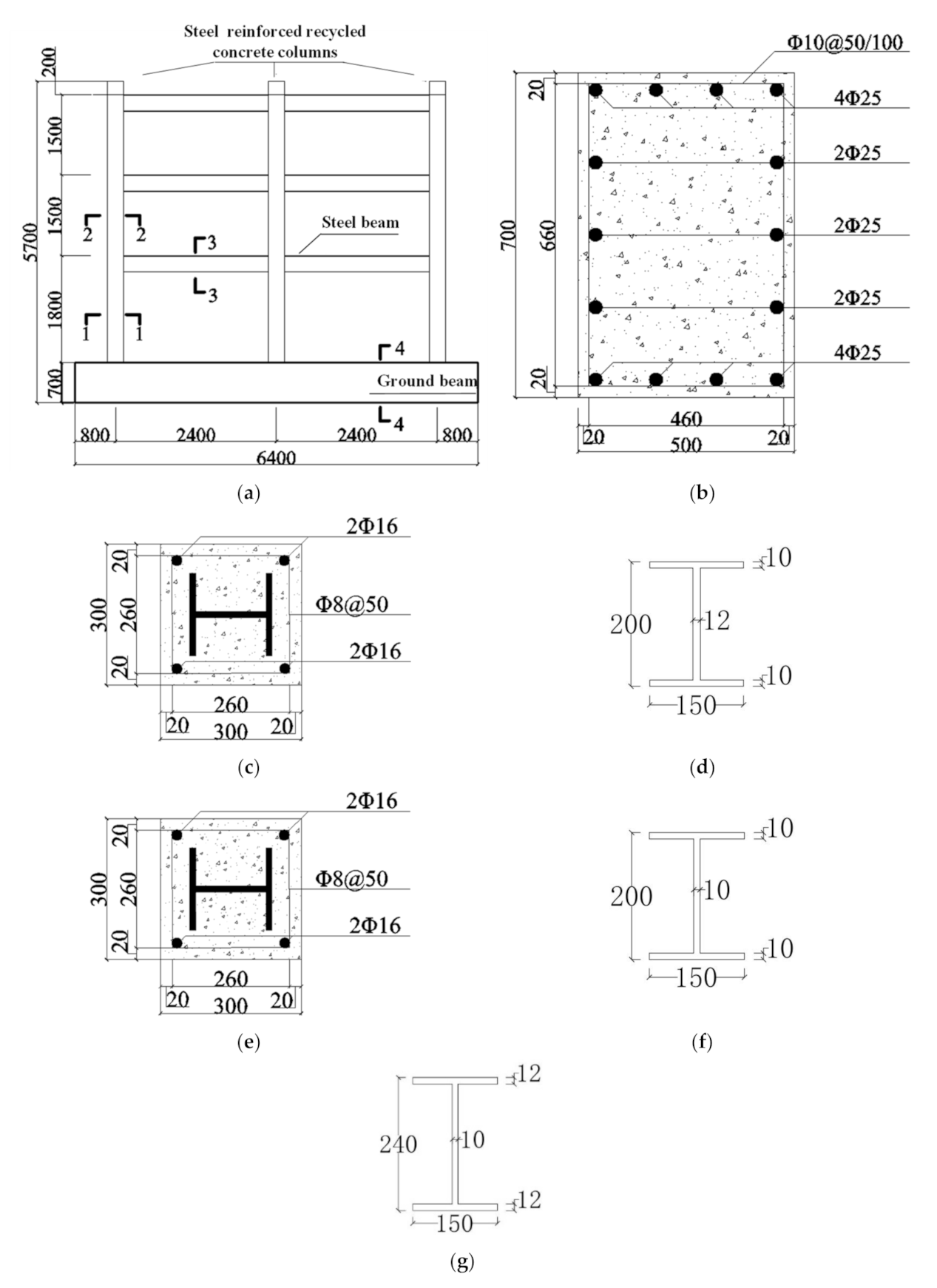
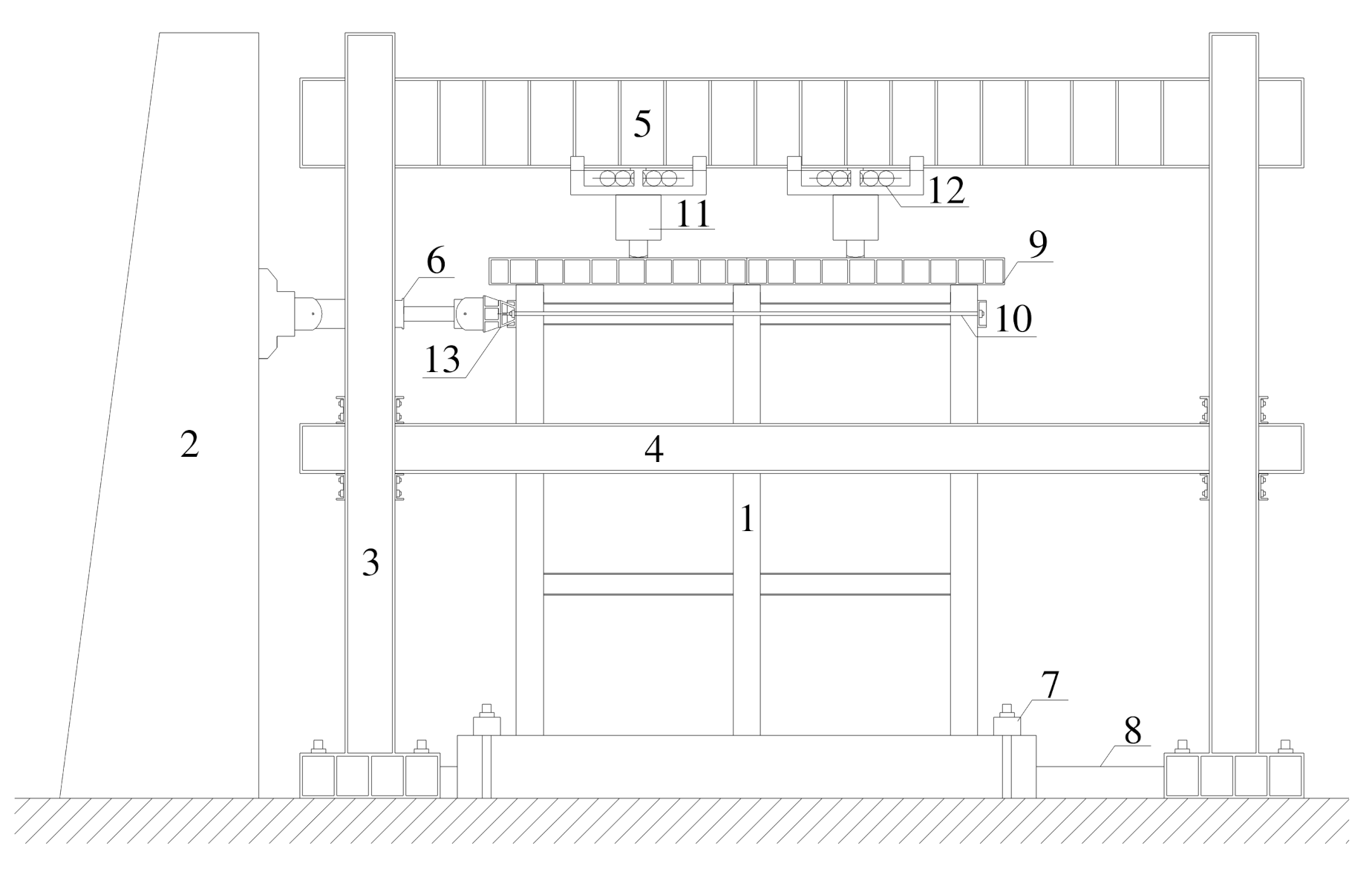
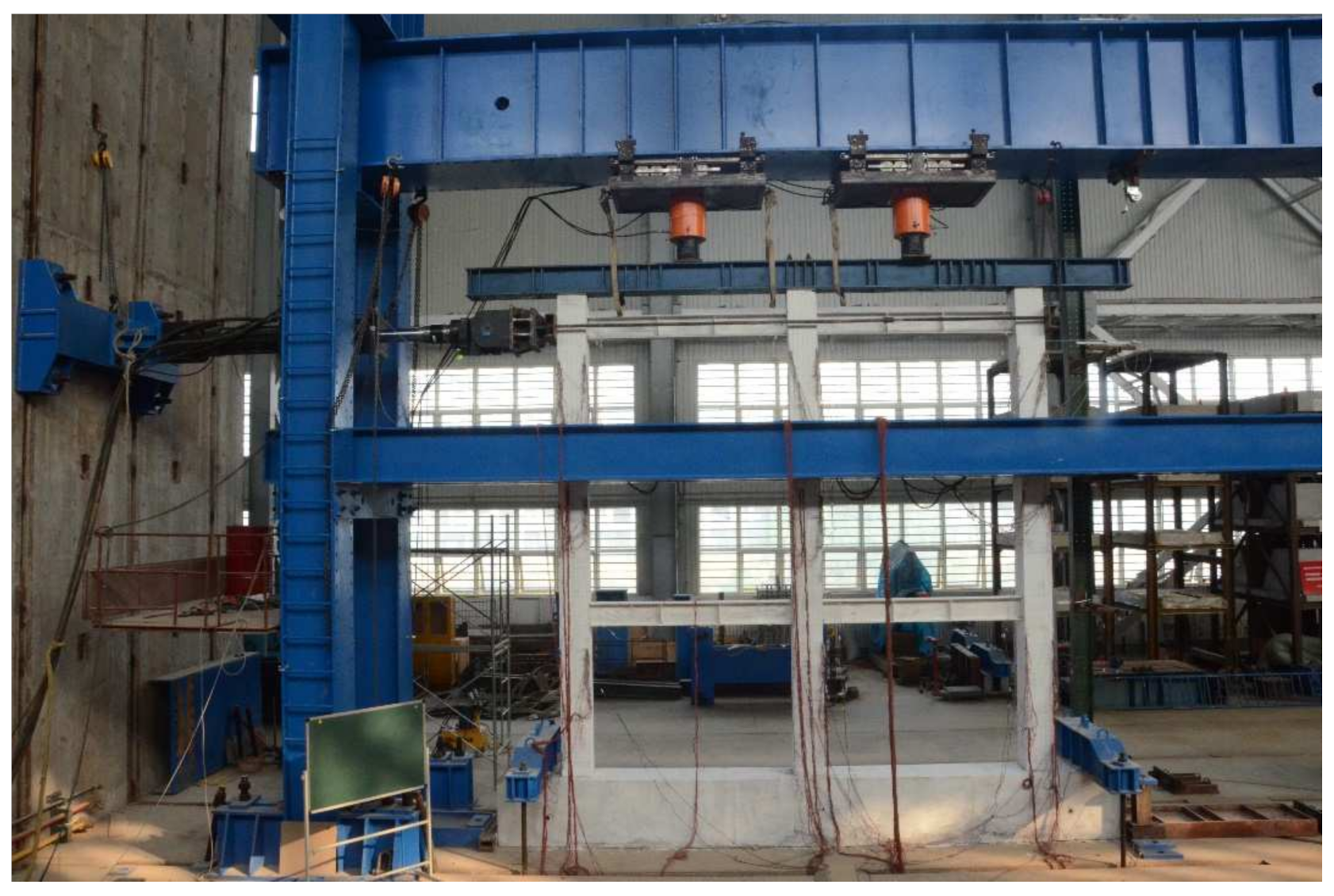
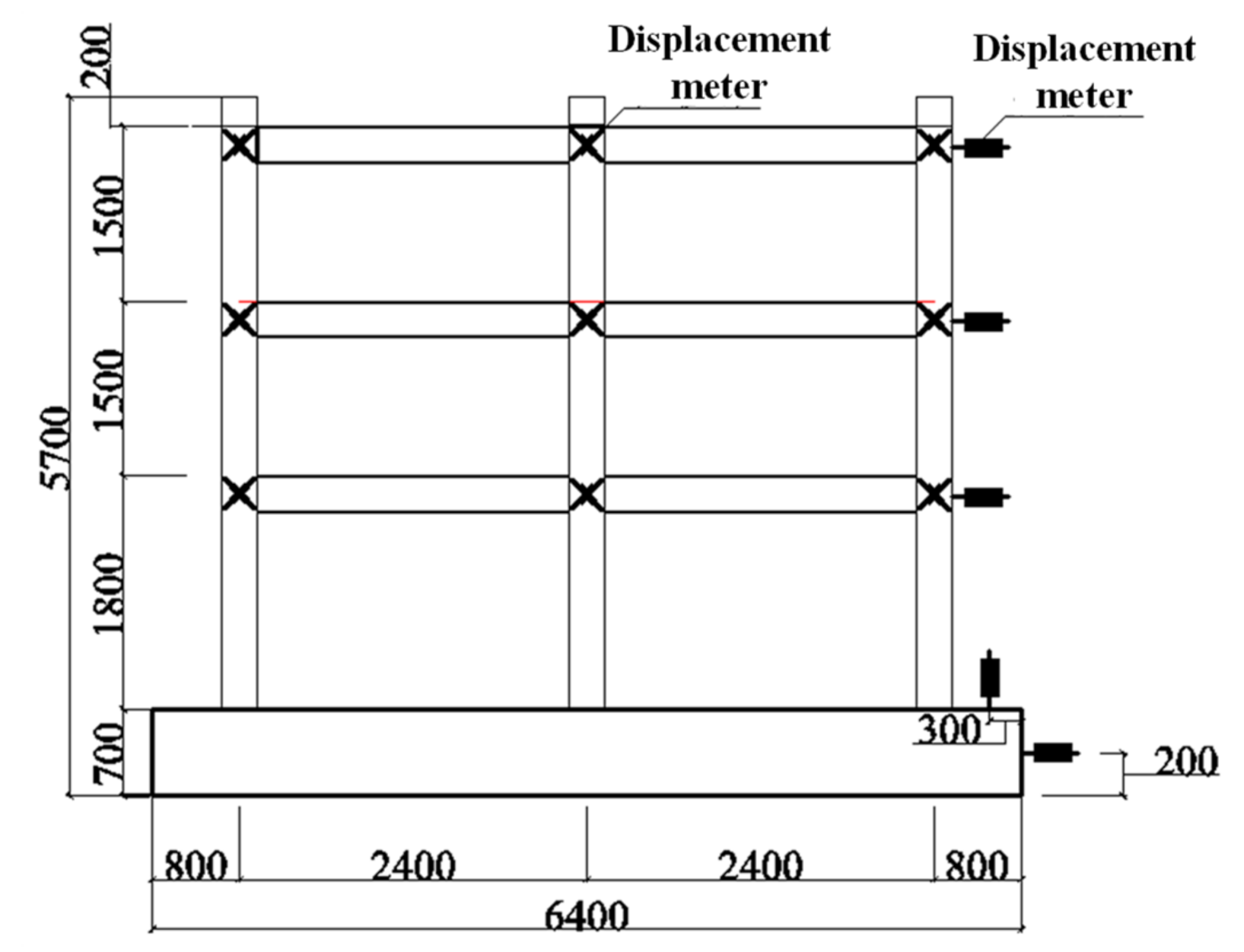
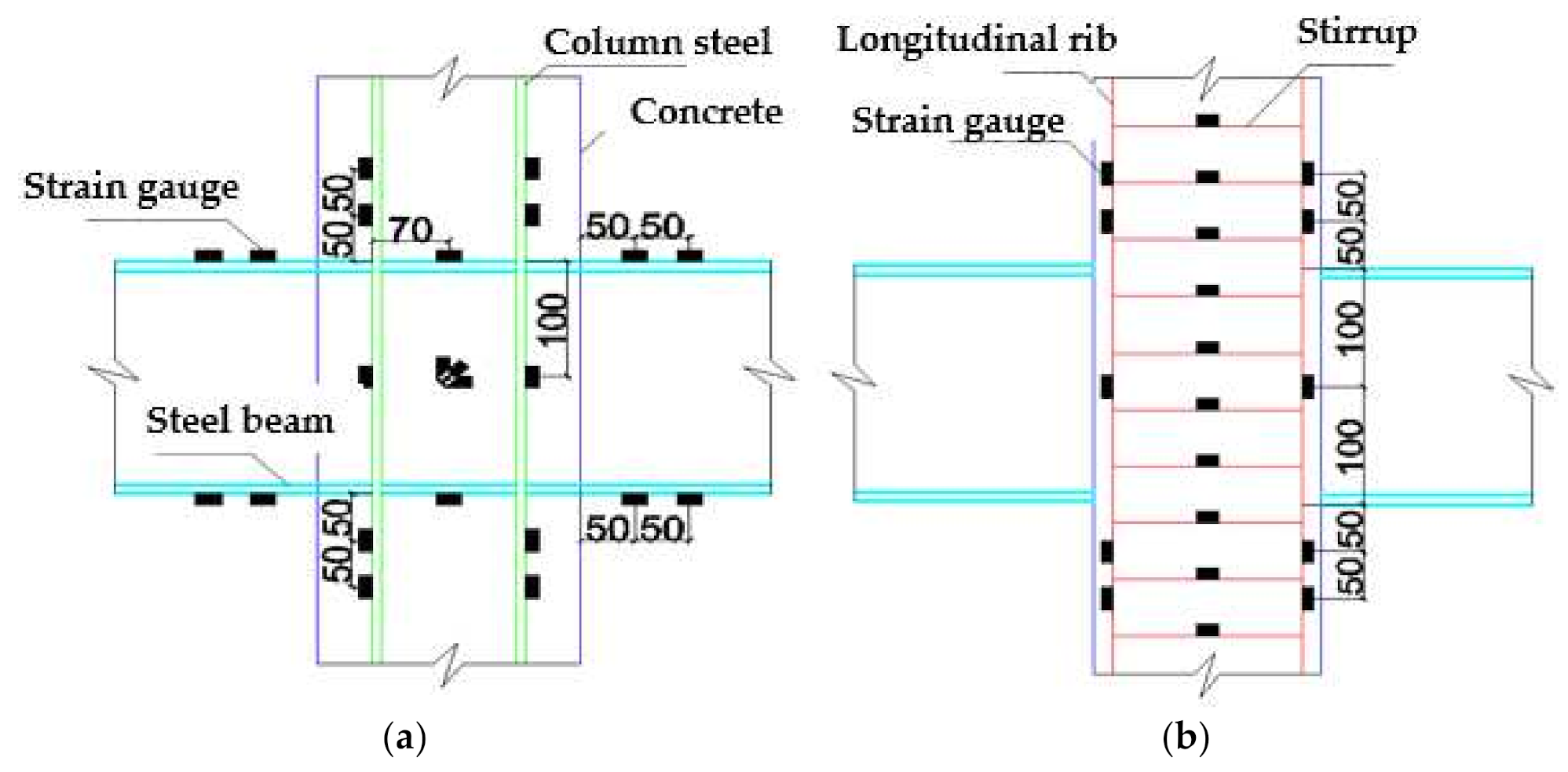
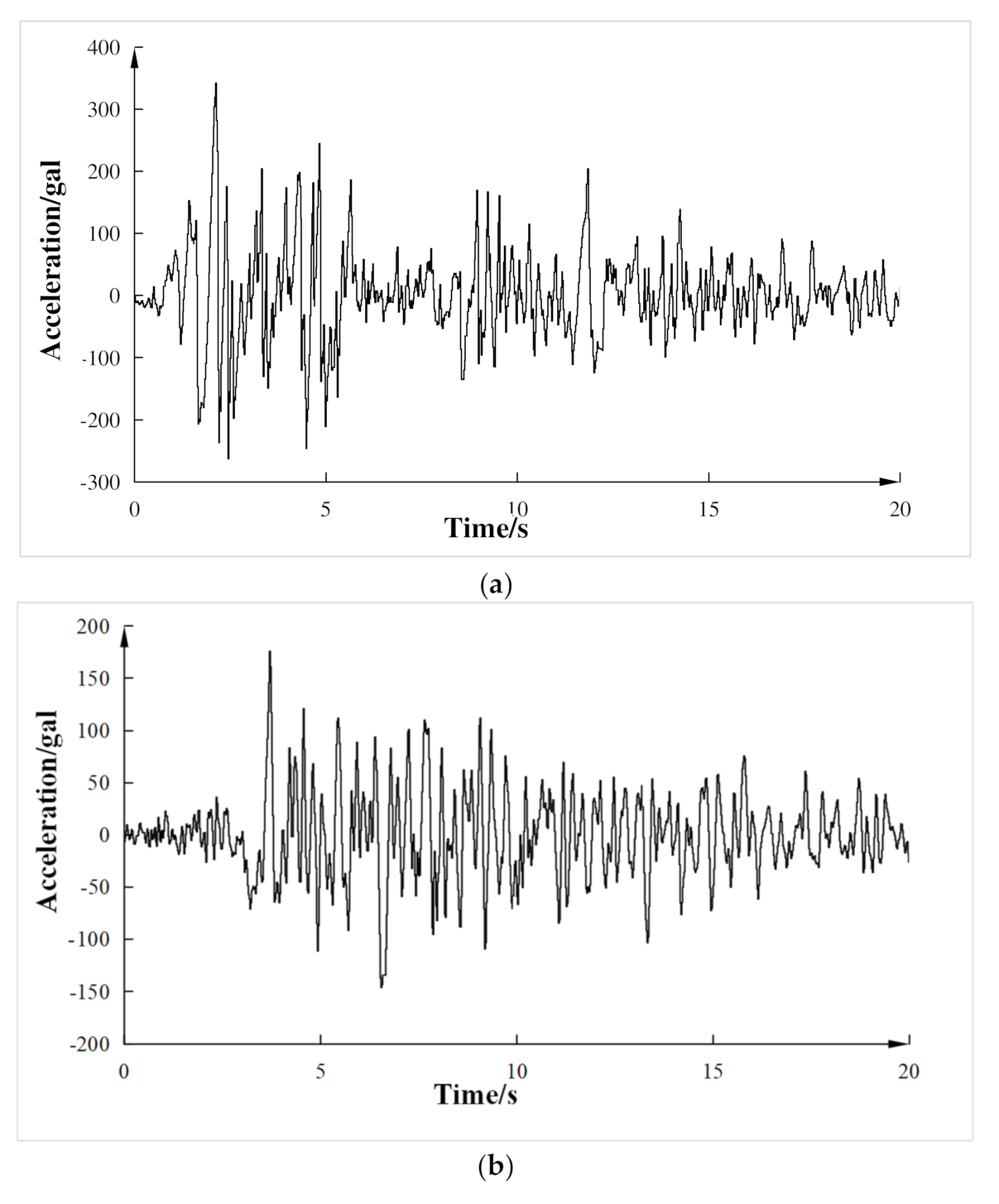
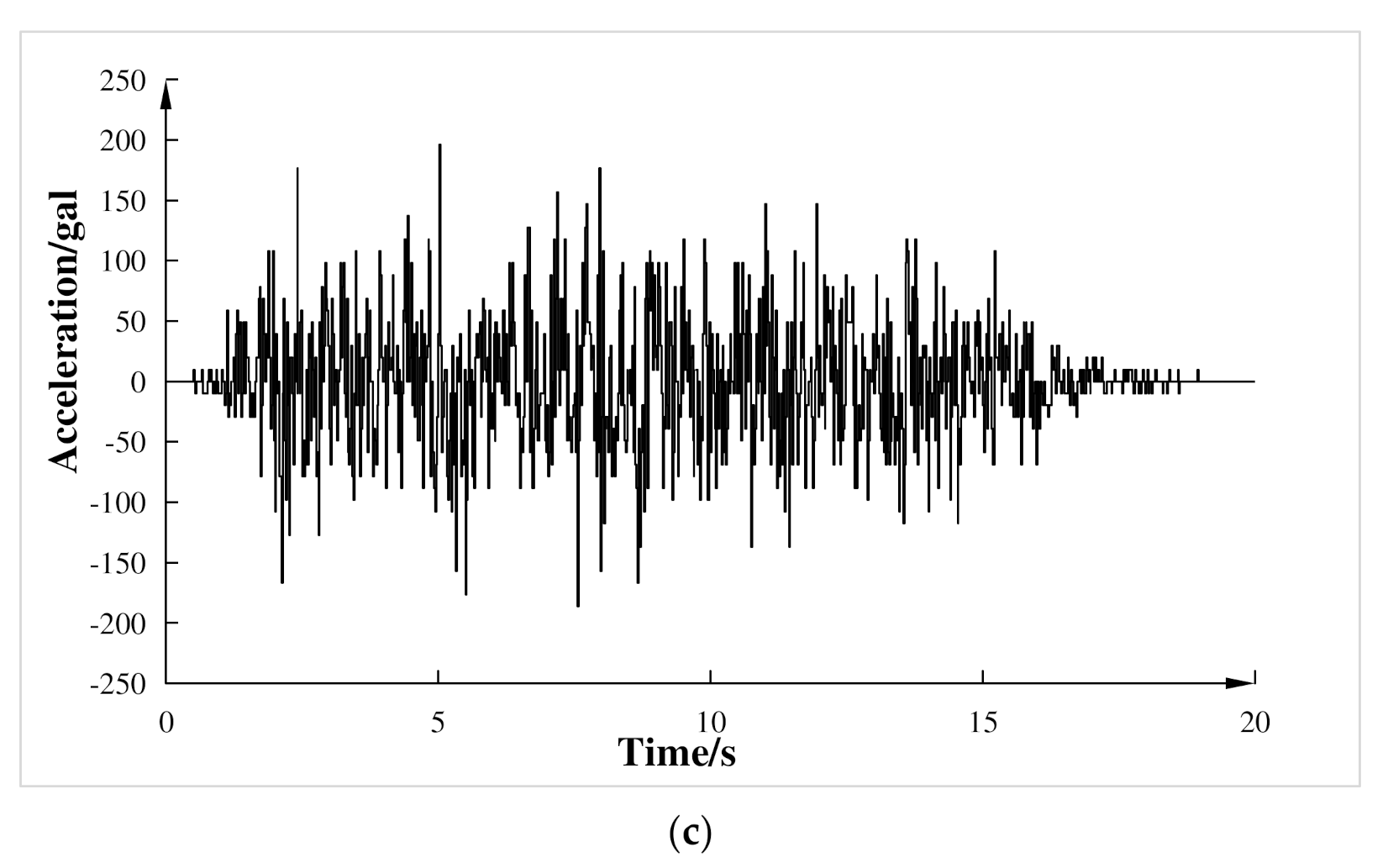
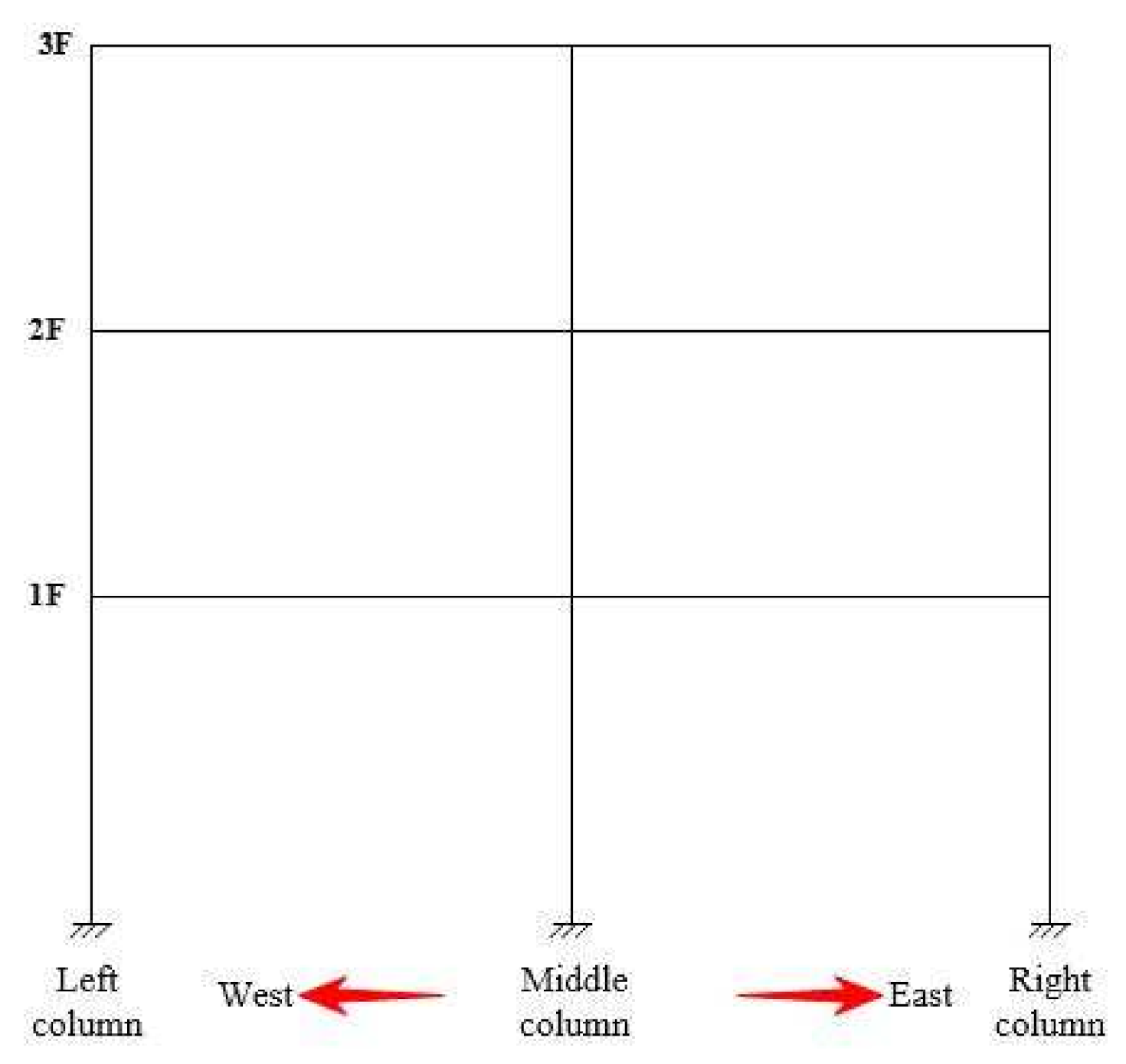
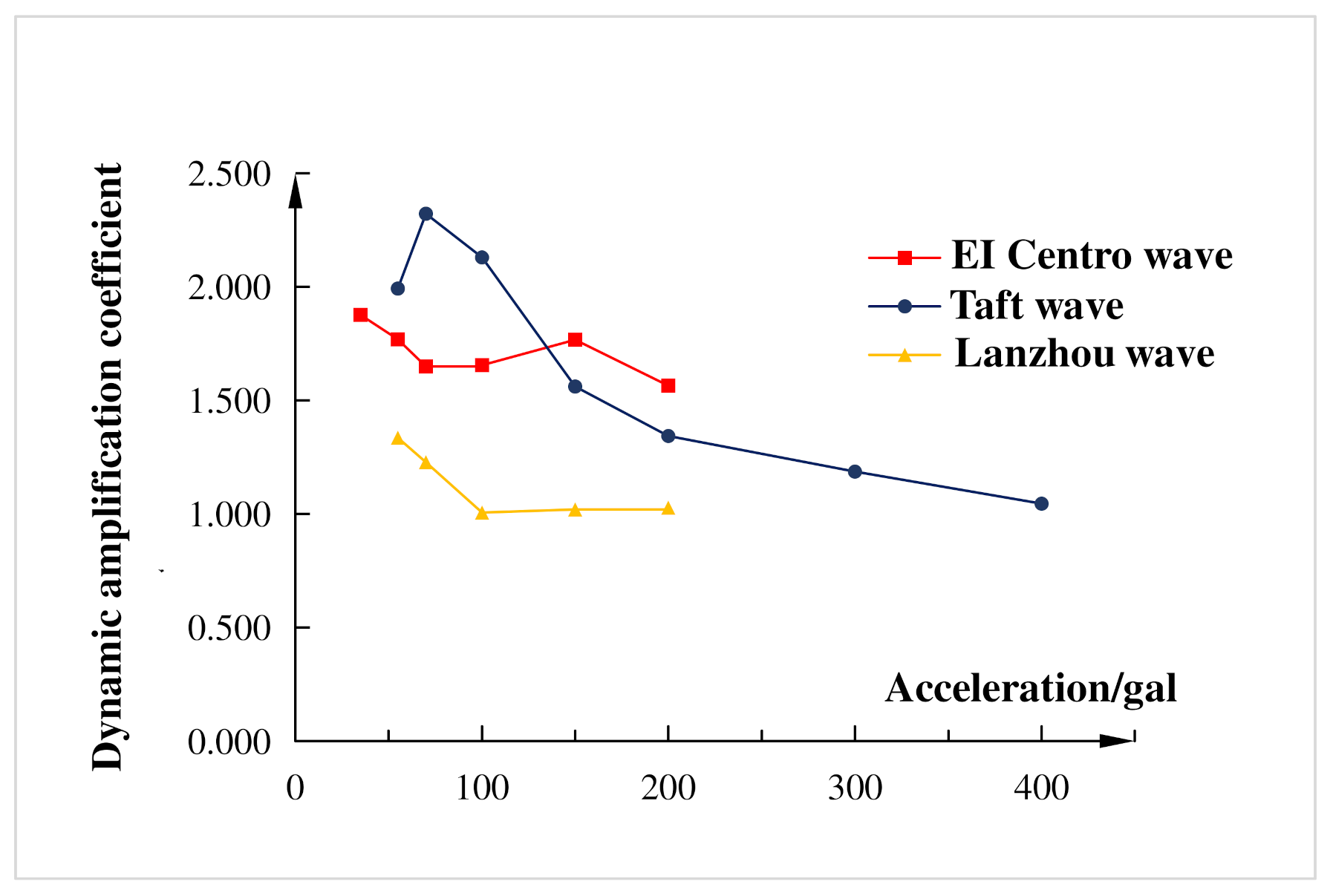


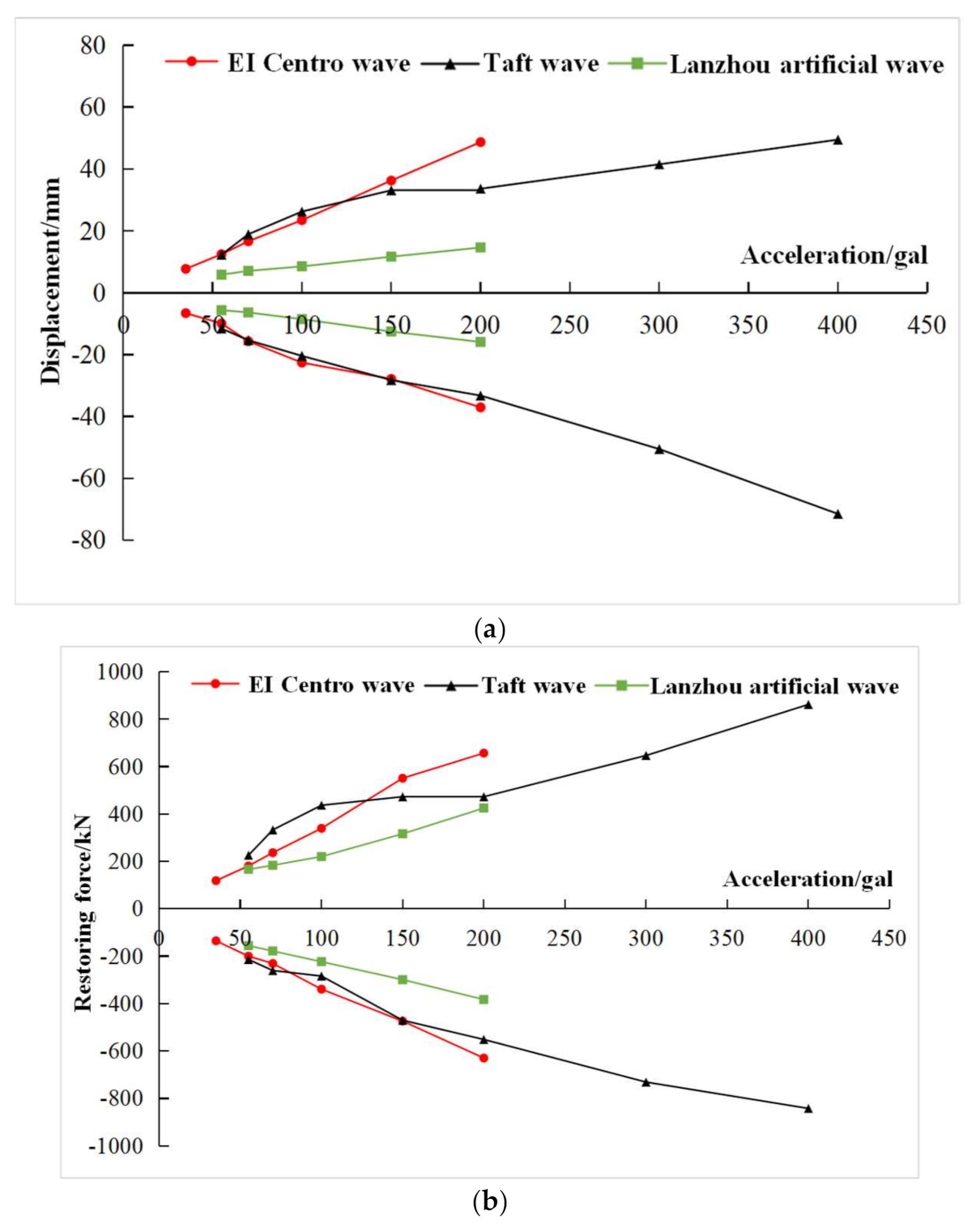
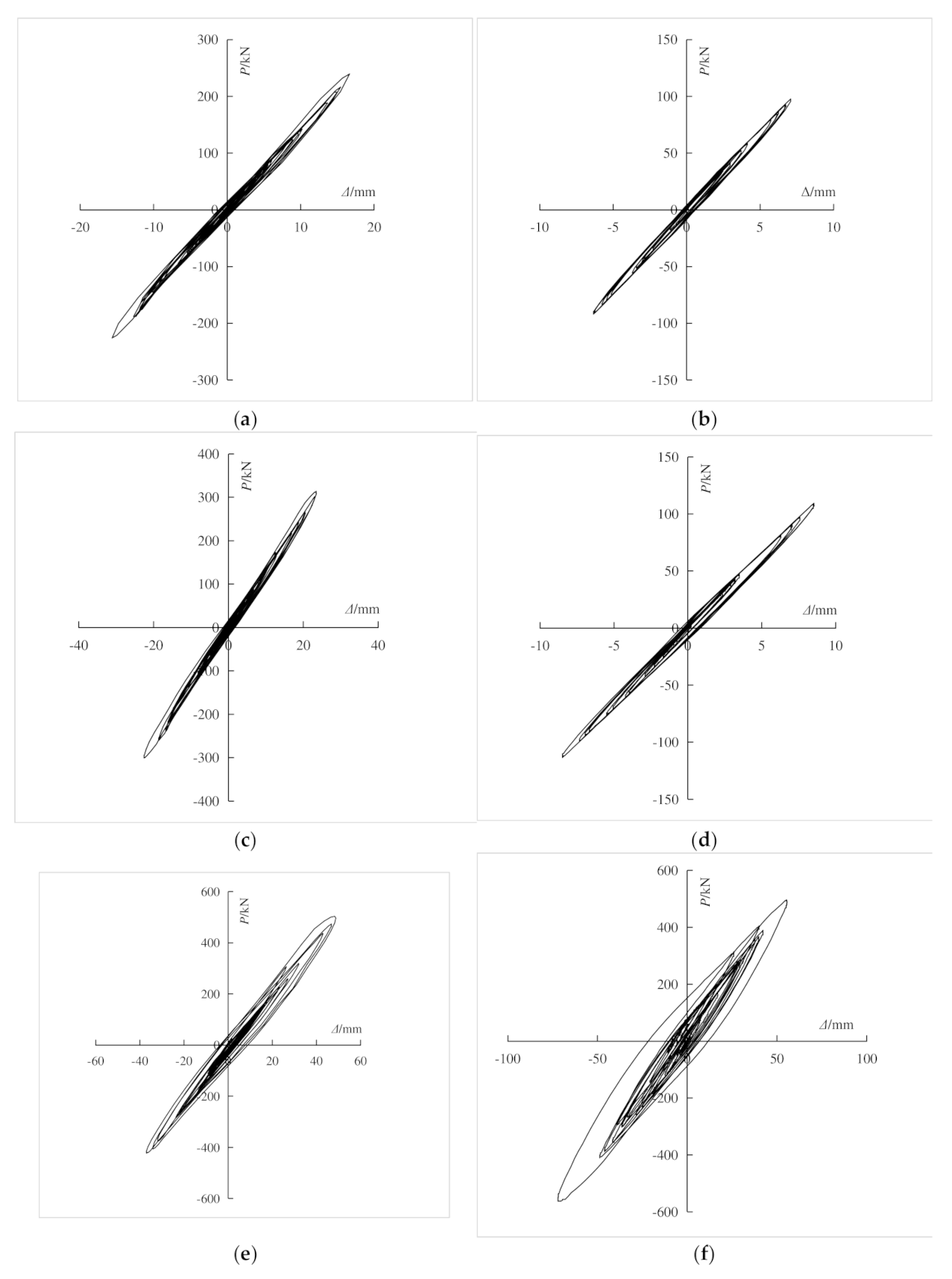
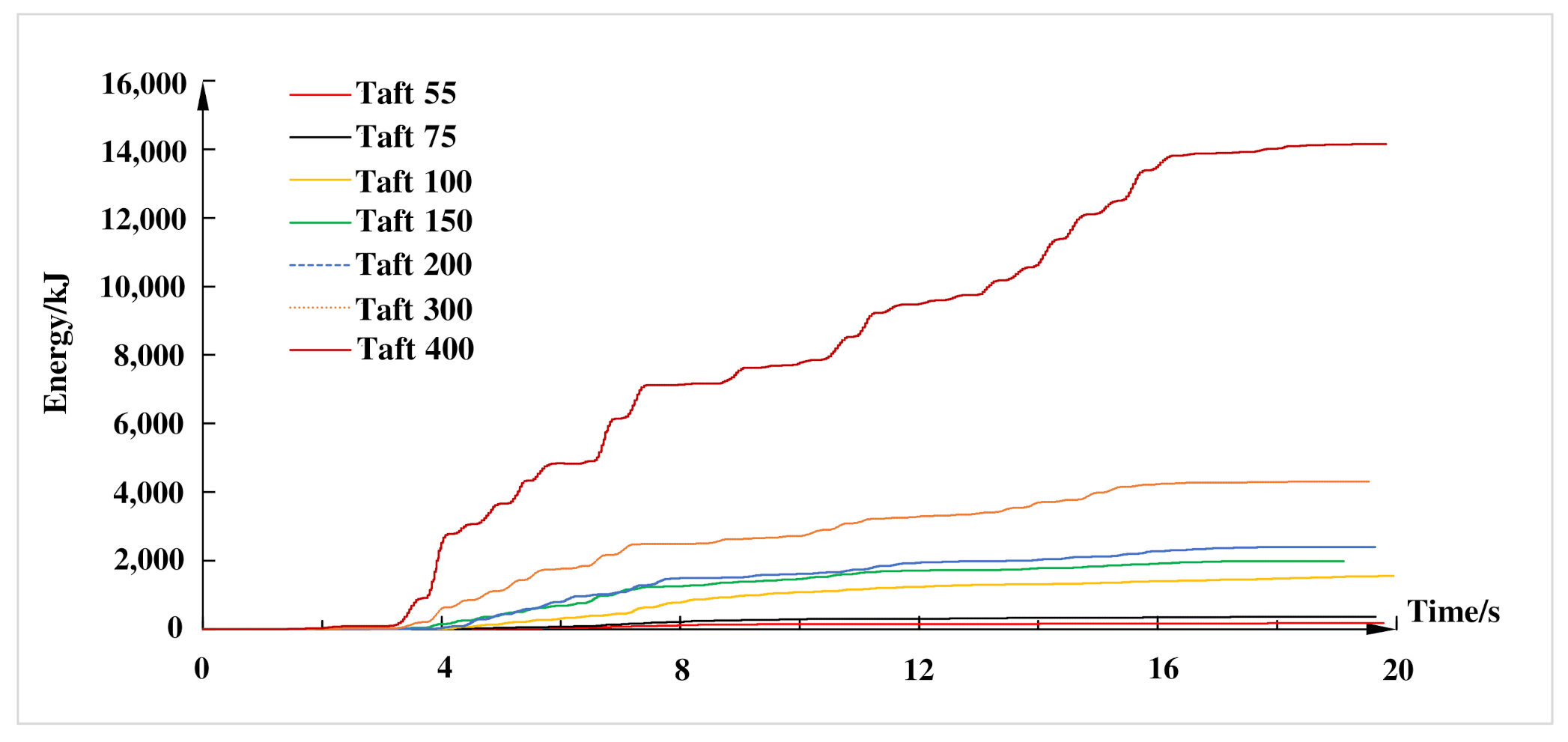
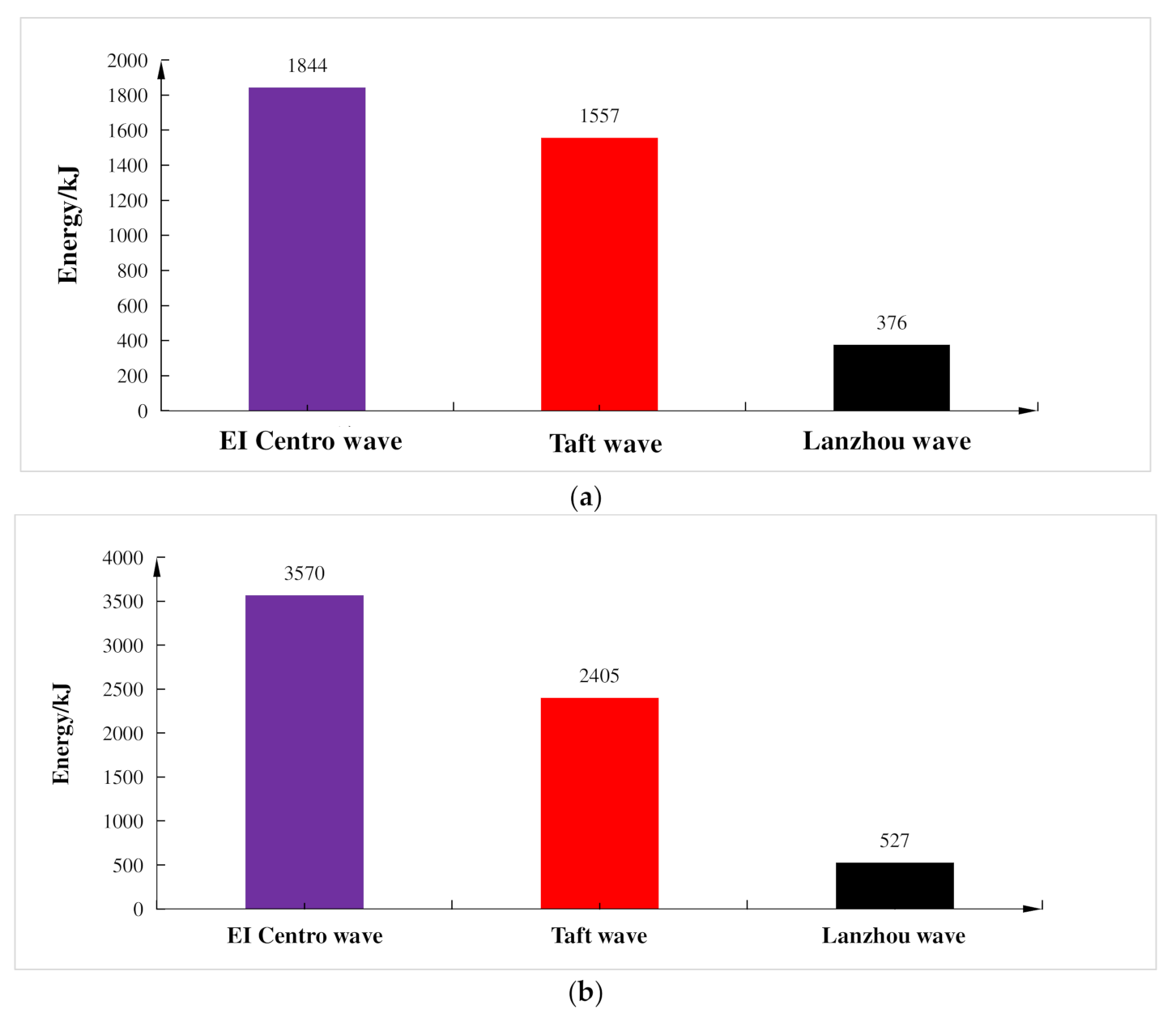
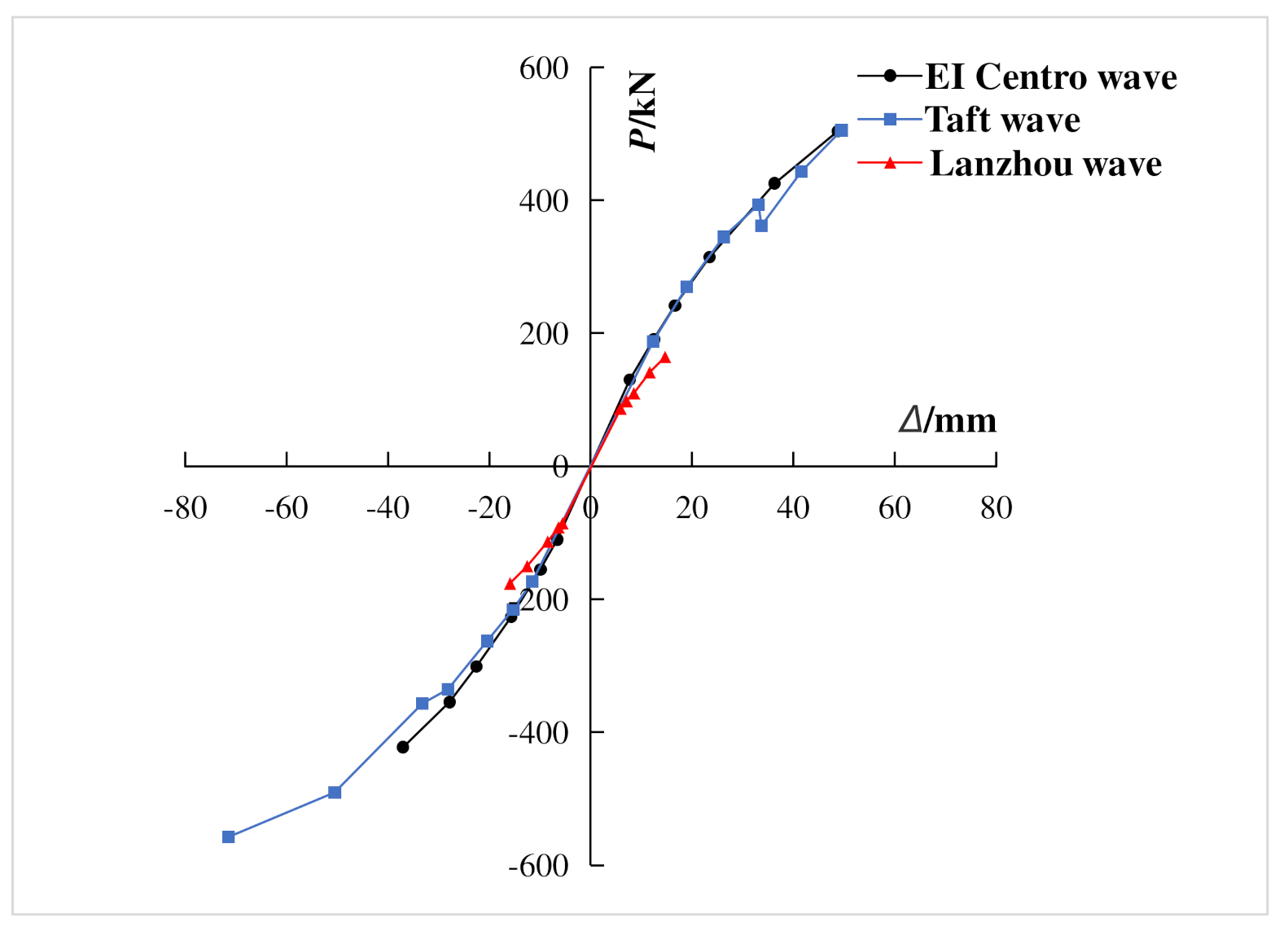

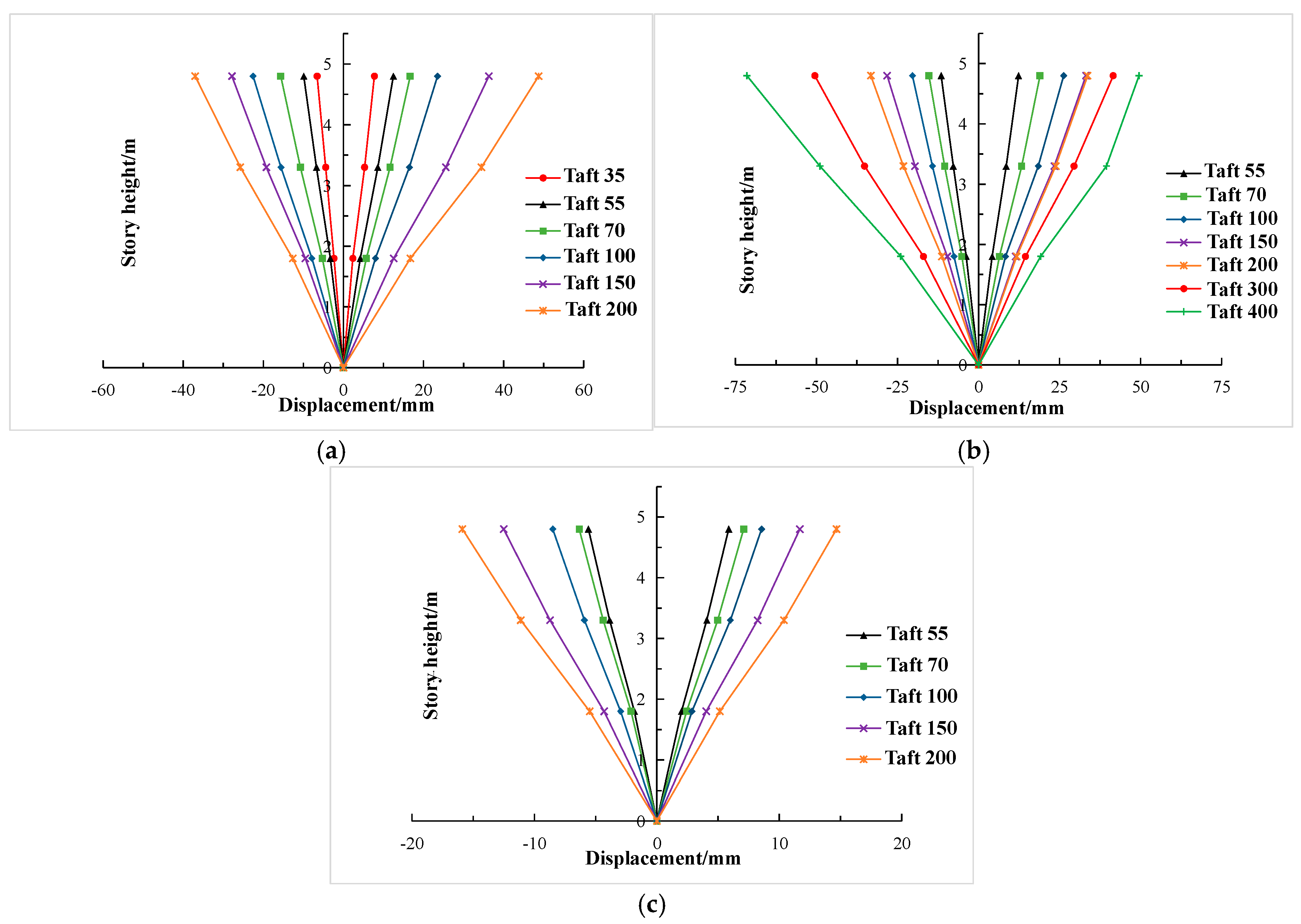

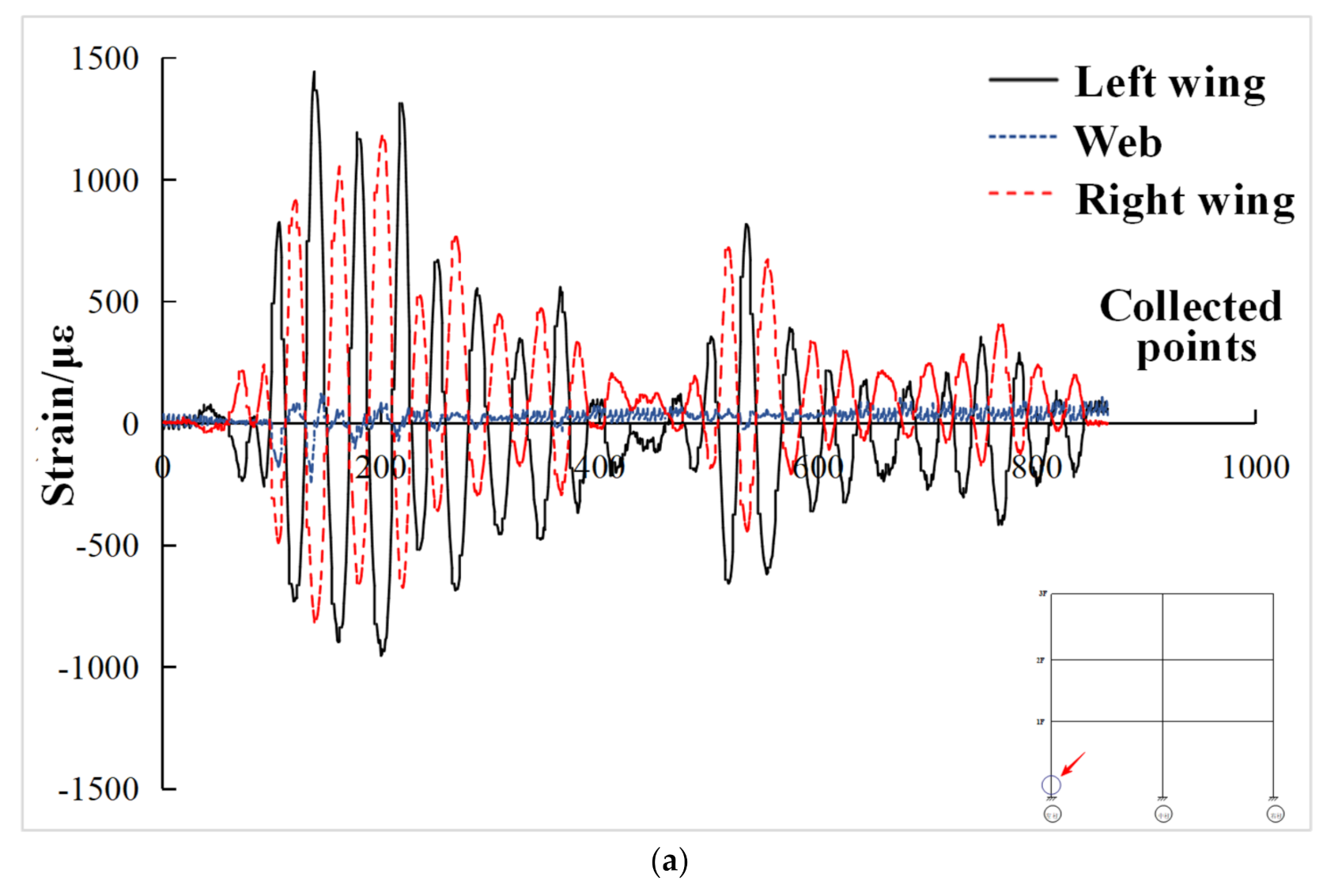
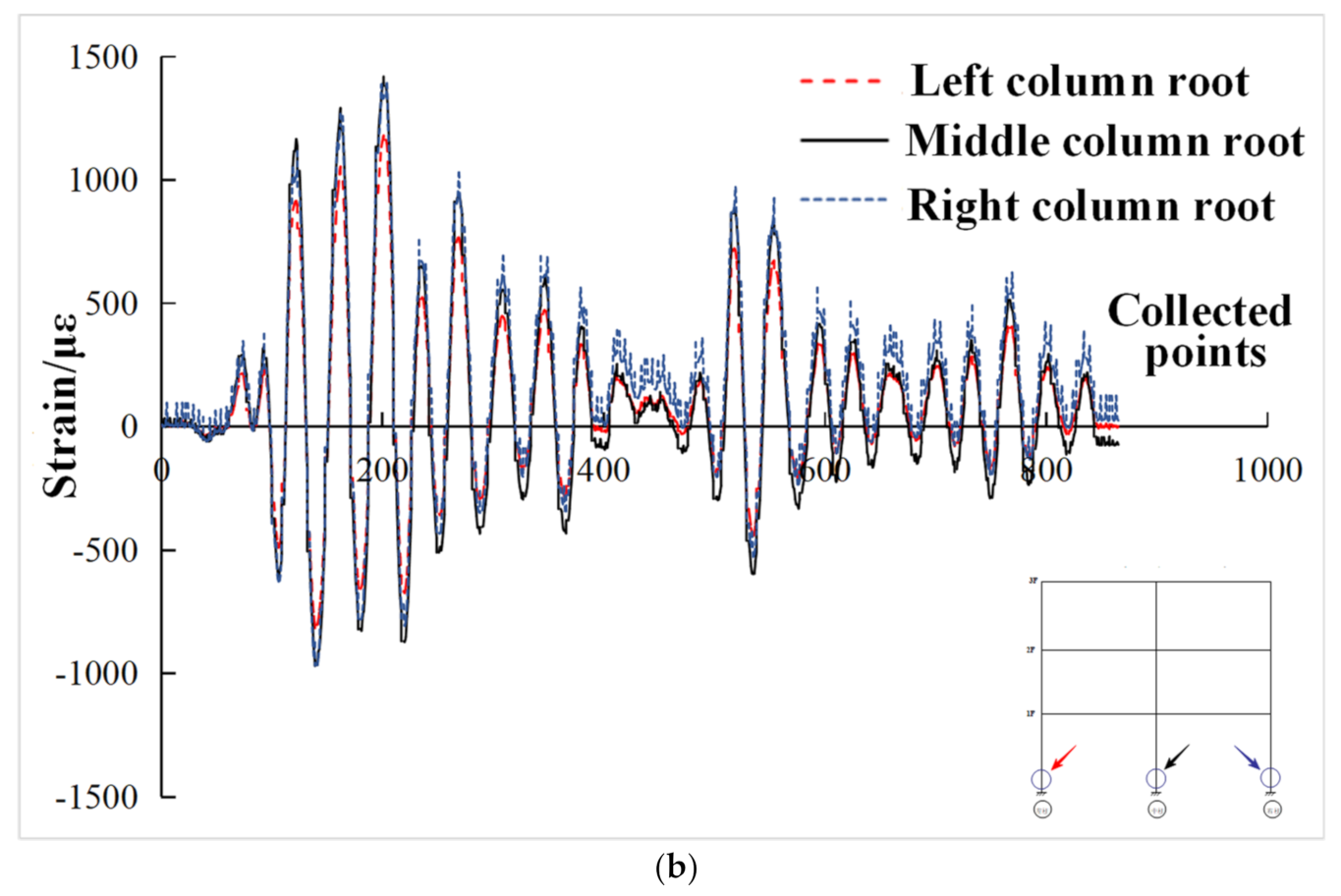
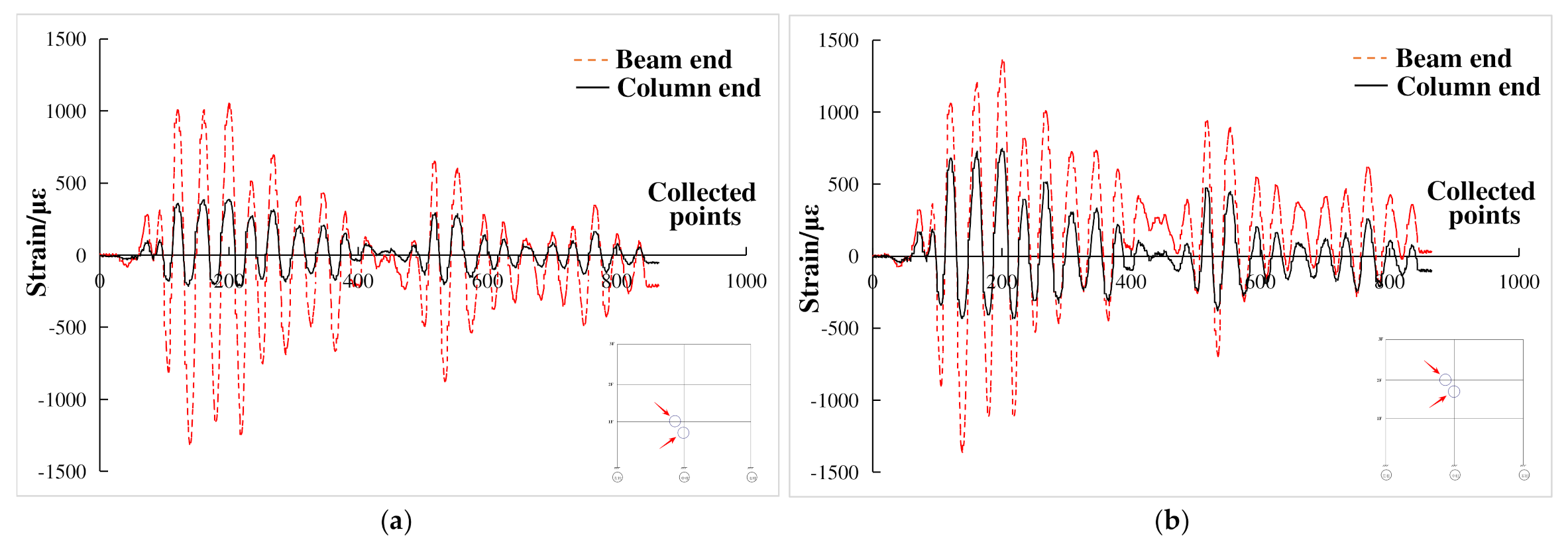
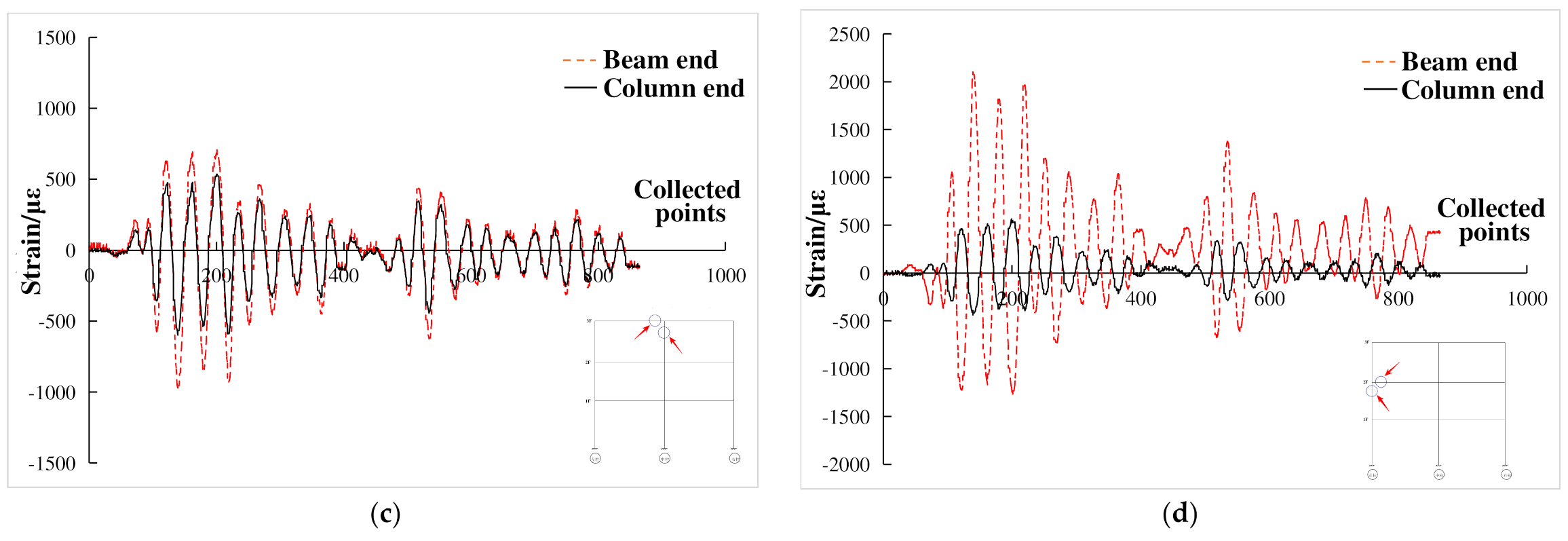
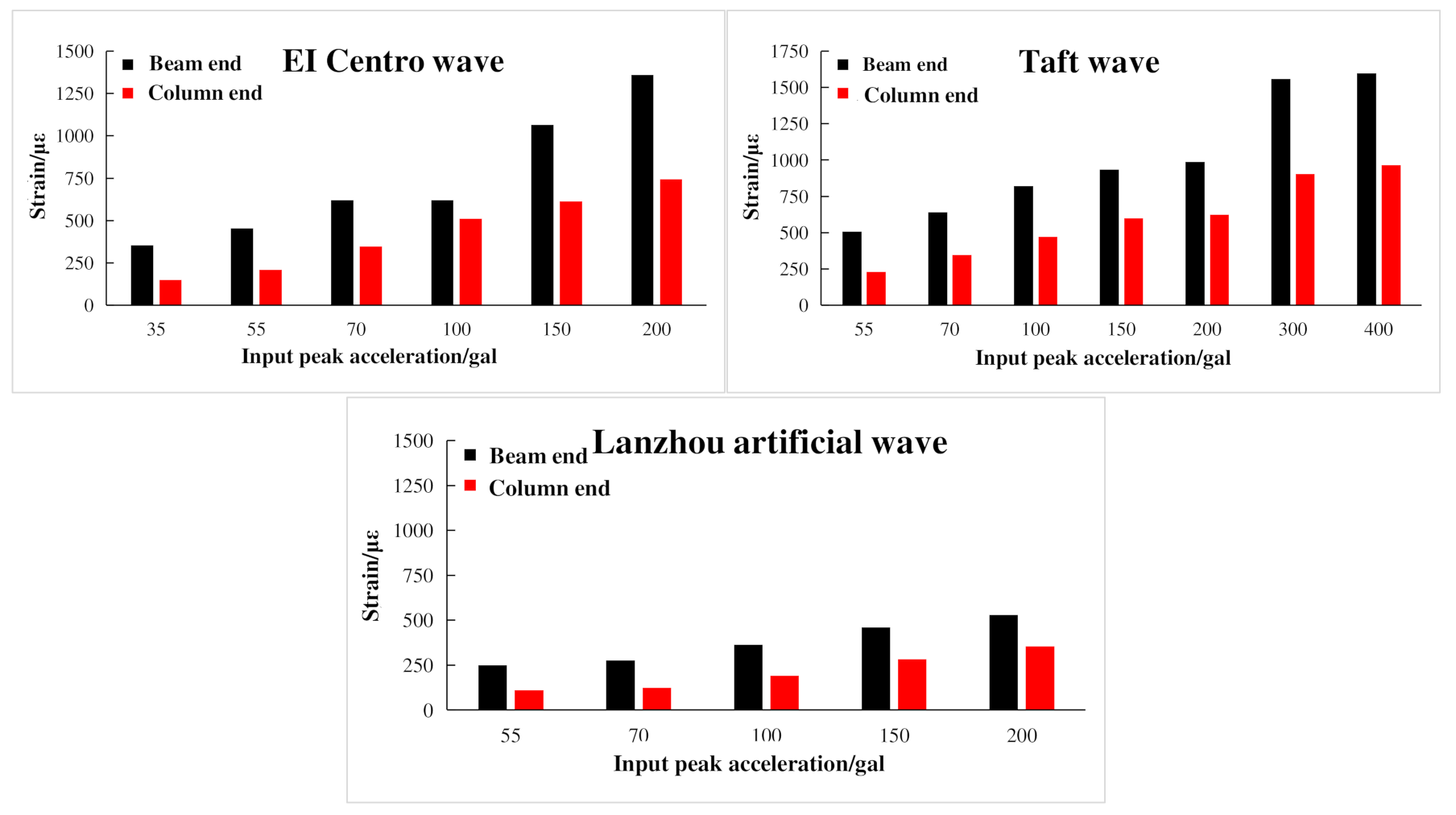
| Steel Diameter (Thickness)/mm | Yield Strength /MPa | Ultimate Strength /MPa | Yield Strain /10−6 | Elastic Modulus /MPa |
|---|---|---|---|---|
| Reinforcement diameter | ||||
| 8 | 391.83 | 555.79 | 1771 | 221.2 × 103 |
| 10 | 361.23 | 515.43 | 1643 | 219.9 × 103 |
| 16 | 377.48 | 531.7 | 1776 | 212.5 × 103 |
| 25 | 306.12 | 398.16 | 1534 | 199.6 × 103 |
| Steel plate thickness | ||||
| 6 | 300.51 | 452.28 | 1485 | 202.3 × 103 |
| 10 | 280.27 | 407.48 | 1568 | 212.1 × 103 |
| 12 | 293.91 | 415.78 | 1519 | 193.5 × 103 |
| Recycled Concrete Strength Grade | Replacement Rate | Cement-Water Ratio (kg/m3) | Cement (kg/m3) | Sand (kg/m3) | Natural Coarse Aggregate (kg/m3) | Recycled Coarse Aggregate (kg/m3) | Water (kg/m3) |
|---|---|---|---|---|---|---|---|
| C40 | 100% | 0.43 | 464 | 585 | 0 | 1187 | 195 |
| Strength Grade | Replacement Rate/r | Cube Compressive Strength frcu/MPa | Axial Tensile Strength frc/MPa | Tensile Strength frt/MPa | Elastic Modulus Erc/MPa |
|---|---|---|---|---|---|
| C45 | 100% | 51.8 | 39.4 | 12.4 | 2.79 × 104 |
| Loading Conditions | Seismic Waves | Peak Acceleration/Gal | Loading Conditions | Seismic Waves | Peak Acceleration/Gal |
|---|---|---|---|---|---|
| 1 | El Centro | 35 | 10 | Taft | 150 |
| 2 | El Centro | 55 | 11 | Taft | 200 |
| 3 | El Centro | 70 | 12 | Taft | 300 |
| 4 | El Centro | 100 | 13 | Taft | 400 |
| 5 | El Centro | 150 | 14 | Lanzhou | 55 |
| 6 | El Centro | 200 | 15 | Lanzhou | 70 |
| 7 | Taft | 55 | 16 | Lanzhou | 100 |
| 8 | Taft | 70 | 17 | Lanzhou | 150 |
| 9 | Taft | 100 | 18 | Lanzhou | 200 |
Publisher’s Note: MDPI stays neutral with regard to jurisdictional claims in published maps and institutional affiliations. |
© 2022 by the authors. Licensee MDPI, Basel, Switzerland. This article is an open access article distributed under the terms and conditions of the Creative Commons Attribution (CC BY) license (https://creativecommons.org/licenses/by/4.0/).
Share and Cite
Dong, J.; Cong, X.; Ma, H.; Liu, Y.; Wang, Y. Pseudo-Dynamic Test on Composite Frame with Steel-Reinforced Recycled Concrete Columns and Steel Beams. Materials 2022, 15, 6355. https://doi.org/10.3390/ma15186355
Dong J, Cong X, Ma H, Liu Y, Wang Y. Pseudo-Dynamic Test on Composite Frame with Steel-Reinforced Recycled Concrete Columns and Steel Beams. Materials. 2022; 15(18):6355. https://doi.org/10.3390/ma15186355
Chicago/Turabian StyleDong, Jing, Xiaoran Cong, Hui Ma, Yunhe Liu, and Ying Wang. 2022. "Pseudo-Dynamic Test on Composite Frame with Steel-Reinforced Recycled Concrete Columns and Steel Beams" Materials 15, no. 18: 6355. https://doi.org/10.3390/ma15186355




